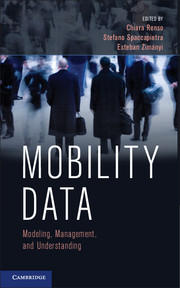Book contents
- Frontmatter
- Contents
- List of Contributors
- Preface
- Acknowledgments
- PART I MOBILITY DATA MODELING AND REPRESENTATION
- 1 Trajectories and Their Representations
- 2 Trajectory Collection and Reconstruction
- 3 Trajectory Databases
- 4 Trajectory Data Warehouses
- 5 Mobility and Uncertainty
- PART II MOBILITY DATA UNDERSTANDING
- PART III MOBILITY APPLICATIONS
- PART IV FUTURE CHALLENGES AND CONCLUSIONS
- Bibliography
- Glossary
- Author Index
- Subject Index
- Plate section
4 - Trajectory Data Warehouses
from PART I - MOBILITY DATA MODELING AND REPRESENTATION
Published online by Cambridge University Press: 05 October 2013
- Frontmatter
- Contents
- List of Contributors
- Preface
- Acknowledgments
- PART I MOBILITY DATA MODELING AND REPRESENTATION
- 1 Trajectories and Their Representations
- 2 Trajectory Collection and Reconstruction
- 3 Trajectory Databases
- 4 Trajectory Data Warehouses
- 5 Mobility and Uncertainty
- PART II MOBILITY DATA UNDERSTANDING
- PART III MOBILITY APPLICATIONS
- PART IV FUTURE CHALLENGES AND CONCLUSIONS
- Bibliography
- Glossary
- Author Index
- Subject Index
- Plate section
Summary
Introduction
In previous chapters we have seen that the usage of location-aware devices enables the collection of large volumes of trajectory data. Effective analysis of such data imposes new challenges for their management, while raising opportunities for discovering behavioral patterns that can be exploited in applications such as location-based services or traffic control management.
Data warehouses (DW) and online analytical processing (OLAP) have been successfully used for transforming detailed data into valuable knowledge for decision-making purposes. Extending DWs for coping with trajectory data, leading to trajectory data warehouses (TDW), allows us to extract essential knowledge from raw or semantic trajectories. For example, a TDW can be used for analyzing the average speed of cars in different urban areas.
Trajectory data in a warehouse must be typically analyzed in conjunction with other data, for example, to find out the correlation between the speed of cars and temperature, precipitation, or elevation. In light of these needs, in this chapter we provide an overall view that integrates trajectory data in a more general data warehousing framework, which we call spatio-temporal data warehousing.
We start this chapter by introducing in Section 4.2 the notion of data warehousing and describing the main elements in a DW architecture. After giving in Section 4.3 the running example used throughout this chapter, we address in Section 4.4 spatio-temporal data warehousing, and show that trajectory data warehouses can be regarded as a particular case of spatio-temporal DW.
- Type
- Chapter
- Information
- Mobility DataModeling, Management, and Understanding, pp. 62 - 82Publisher: Cambridge University PressPrint publication year: 2013
- 5
- Cited by



